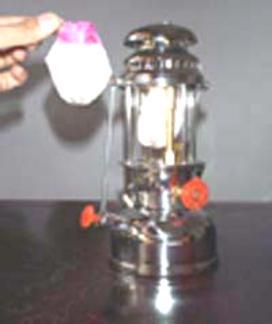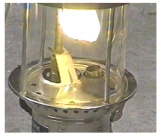|
|
 |

The PETROMAX Multi-Fuel Lantern
"PETROMAX" lanterns were designed and developed
by Adolf & Max Graetz, who were appointed managing directors of their family business (Ehrich & Graetz) in 1889.
From their efforts arose the most powerful
& reliable lanterns in the world. Petromax lanterns run on a variety of fuels.... kerosene, alcohol-based fuels, mineral
spirits, citronella oil, gasoline, diesel oil, & almost every flammable fuel available on the market.
The first lanterns developed, named Petromax,
were used by the German army before and during World War Two. The military significance of a lantern that would burn all liquid
fuels from diesel oil to gasoline made the lantern very useful. Also developed were heaters and stoves. These three items
gave the German army the benefit of heat, light and a way to prepare food with the use of any liquid fuel available.
The German army and many other military service
including NATO forces still use the same product line of the original company. All of the lanterns, stoves and heaters used
today, by the general public world wide, are known to be reliable and easy to repair. With the use of kerosene as the fuel
of choice, this lantern has a problem free life of decades if a little tender loving care is bestowed upon it.
Gas Mantles are used in Petromax Lanterns for
lighting and heating purpose. The light intensity of Gas Mantles is either defined in LUX or CANDLE POWER, shortly abbreviated,
as C.P. Gas Mantles are available from 100 C.P. to 1000 C.P. However the most popularly used are 300-400 C.P. and 400-500
C.P.
We are in this line of manufacturing gas mantles
since 1960 and we are the registered trademark owners of the popular brands like Kanhaiya Gas Mantles and Rahi Gas Mantles
to our credit widely being used in India and abroad. We do and we can tailor make Gas Mantle in any Candle Power.
For more information contact:
ILYAS YUSUF MAKANI ilyasmakani@yahoo.com
YUSUF PRODUCTS
17/D, Memonwada Road, Mumbai: 400 003.
India.
Phones: (91)(22) 23454698, 23723564.
Fax: (91)(22)
23746242.
www.muby.itgo.com
|
 |
Gas Mantle
An incandescent gas mantle, gas
mantle, or Welsbach mantle is a device for generating bright white light when heated by a flame. The name refers
to its original heat source, existing gas- lights, which filled the streets of Europe and North America in the late 19th century,
mantle referring to the way it was hung above the flame. Today they are still used for portable camping lanterns and pressure
lamps.
They work by utilising the heat of a flame,
in modern portable applications produced using kerosene or LPG, to heat them up to around 1000 degrees celsius. At this temperature
they are sufficiently hot to radiate an intense white light as a consequence of the spectral lines of rare earth elements
in the mantle. The light is not produced through black body radiation since the temperature is too low to generate white light.
Modern mantles are made of ramie-based artificial
silk or rayon. When the mantle, a small net bag, is attached to the lamp and used for the first time, the heat burns away
the cellulose of the bag and converts the rare earth nitrates soaked into it into a rigid, but very fragile, structure made
of metal oxides.
Since thorium is radioactive, and produces
a radioactive gas, radon-220 as one of its decay products there are concerns about the safety of thorium mantles. Some nuclear
safety agencies make recommendations about their use. A study in 1981 estimated that the dose from using a thorium mantle
every weekend for a year would be 0.3-0.6 millirems, tiny in comparison to the normal annual dose of a few hundred millirems
although a person ingesting an entire mantle would receive a comparable dose of 200 mrem. However the radioactivity is a major
concern for those people involved with the manufacture of mantles, and with contamination of soil around some former factory
sites. All of these issues have meant that alternatives, usually yttrium or sometimes zirconium, are used in some countries
although they are either more expensive or less efficient.
|
 |
History
For centuries, artificial light had been generated using open flames. Limelight had been invented in
the 1820s but the temperature required was too high to be practical for small lights. In the late 19th Century several inventors
tried to develop an effective alternative based on heating a material to a lower temperature but using spectral lines to simulate
white light.
Many early attempts used platinum / iridium gauzes soaked in the metal nitrates, but were not successful because
of the high cost of the materials and poor reliability. The first effective mantle was the Clamond basket in 1881,
named after its inventor. It was exhibited in the Crystal Palace exhibition of 1883. This device was made from a mixture of
magnesium hydrate, magnesium acetate and water which was squeezed through holes in a plate to form threads, which were then
moulded into a basket shape and ignited. The acetate burnt, the combustion products forming a matrix to support the magnesium
oxide formed as the hydrate decomposed. The fragile structure was supported by a platinum wire cage and heated by a coal gas
flame.
The modern gas mantle was one of the many inventions of Carl Auer von Welsbach, a chemist who studied rare earth
elements in the 1880s and who had been a student of Robert Bunsen. His first process used a mixture of 60 percent magnesium
oxide, 20 percent lanthanum oxide and 20 percent yttrium oxide, which he called Actinophor, and patented in 1885.
The original mantles gave off a green-tinted light and were not very successful, and his first company, which
established a factory in Atzgersdorf in 1887, failed in 1889. In 1890 he discovered that thorium
was superior to magnesium, and in 1891 perfected a new mixture of 99 percent thorium dioxide and 1 percent cerium dioxide
gave off a much "whiter" light, and the thorium oxide added considerably to the strength of the mantle. After introducing
it commercially in 1892 it quickly spread throughout Europe. The gas mantle remained an important part of street lighting
until the widespread introduction of electric lighting in the early 1900s.
To produce a mantle, cotton is woven into a net bag and impregnated with the soluble nitrates of these metals
and then heated; the cotton burns away and the nitrates are converted to nitrites that fuse together to form the solid mesh.
As the heating continues, the nitrites decompose into the final solid, (but fragile) very high melting point oxides.
Early mantles were sold in the unheated cotton mesh condition, since the oxide structure was too fragile to
transport easily and the purchaser carried out the conversion when it was first used. The cotton quickly rotted because of
the corrosive nature of the acidic metal nitrates (although was later reduced by soaking the mantle in ammonia solution to
neutralise the excess acid).
Later mantles were made from guncotton or collodian rather than ordinary cotton, since extremely fine threads
of it could be produced; it was converted back to cellulose before heating (since these materials are highly flammable or
explosive) by dipping in ammonium sulfide.
It was discovered that the finished mantle could be strengthened sufficiently by dipping in a solution of collodion
which would coat it with a thin layer of the material to be burnt off when the mantle was first used, although modern mantles
are now usually sold in their original fabric condition. Early
mantles often had a binding thread of asbestos for tying onto the lamp fitting, but because of its carcinogenic properties
it has been replaced with wire in modern mantles.
|
|
 |
|
FEW FACTS ABOUT GAS MANTLES
A
Gas Mantle is a device that gives of considerable light when heated. The name refers to its original power source, existing
gaslights, which filled the streets of Europe and North America in the late 19th Century mantle, referring to the
way it hung above the flame. Gas Mantles are still being used in Uttar Pradesh and Bihar in India, Afghanistan, Pakistan and
Bangladesh. The gas mantle was one of the many inventions of Auer von Welsbach, a chemist who studied rare earth element in
1880. His first process used a mixture of 60% Magnesium Oxide, 20% Lanthanum Oxide and 20% Yttrium Oxide, which he called
Actinophor. To produce a mantle guncotton is impregnated with the mixture and then heated, the cotton burns away leaving a
solid, but fragile mesh of ash. These original mantles gave off a green tinted light and were not very successful, and his
first company formed to sell them failed in 1889. A new mixture of 99% Thorium Oxide and 1% Cerium Oxide gave off much whiter
light, and after introducing it commercially in 1892 it quickly spread through out Europe. The gas mantle remained an important
part of street lighting until the wide spread of electric lighting in early 1900. A mantle is basically a small sock made
of silk or asbestos. Asbestos can withstand high temperatures, but is also toxic. Silk-based mantles are extremely brittle
once first burnt and must be replaced frequently. Thorium is radioactive, and Pure Thorium becomes more radioactive as it
ages owing to its decay products. It should be handled with care. Owing to concerns about radioactivity, alternatives are
now used in some countries, but these are more expensive and less efficient. Though studies conducted by the members of Indian
Gas Mantle Manufacturers Association in Northern Parts of India have shown that use of thorium based gas mantle is not a health
hazard due to negligible amount of Thorium content in each gas mantle. The negligible Thorium content also make it non hazardous
to environment as well. However to make non radioactive gas mantle a mixture of Yttrium Nitrate and Europium Nitrate is used
on a woven sock of man made rayon.
Our
belief in Gandhiji's Theory
"A customer is the most important visitor on our premises. He is not dependent on us. We are dependent
on him. He is not an interruption of our work. He is the purpose of it. He is not an outsider to our
business. He is part of it. We are not doing him a favour by serving him. He is doing us a favour by
giving us the opportunity to do so."
(Mahatma Gandhi 1869-1948)
 |
 |
|
|
|
|
For Clacium Chloride, Zinc Chloride and Phase
Change Materials write to
Simrone Products, S-8, Sarifa Mansion, Second Flank Road, Mumbai: 400009. India.
For our Chemical Division
http://www.pcmenergy.com/
YUSUF PRODUCTS
17/D, Memonwada Road, Mumbai: 400 003. India
|
|
|
 |

